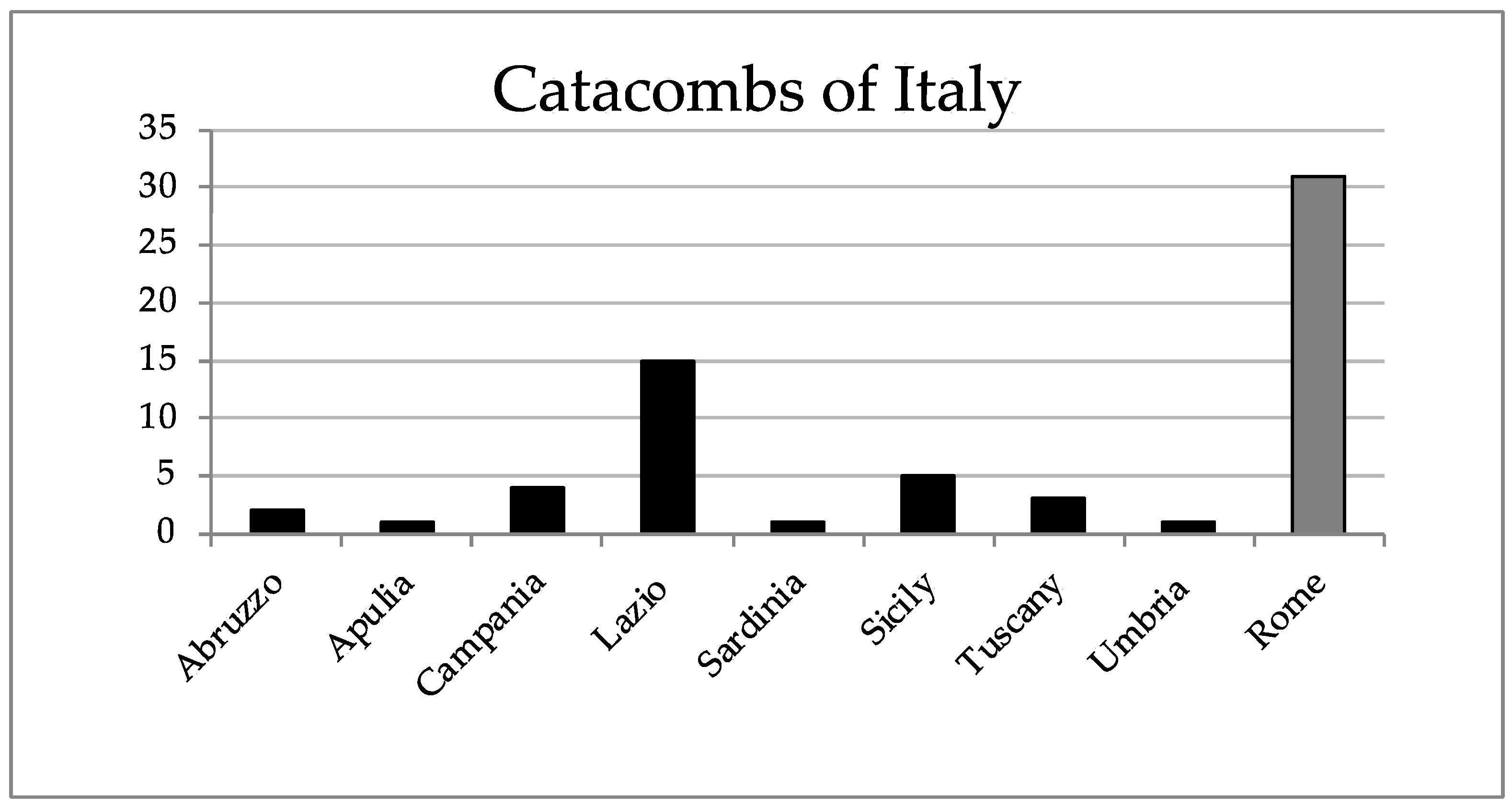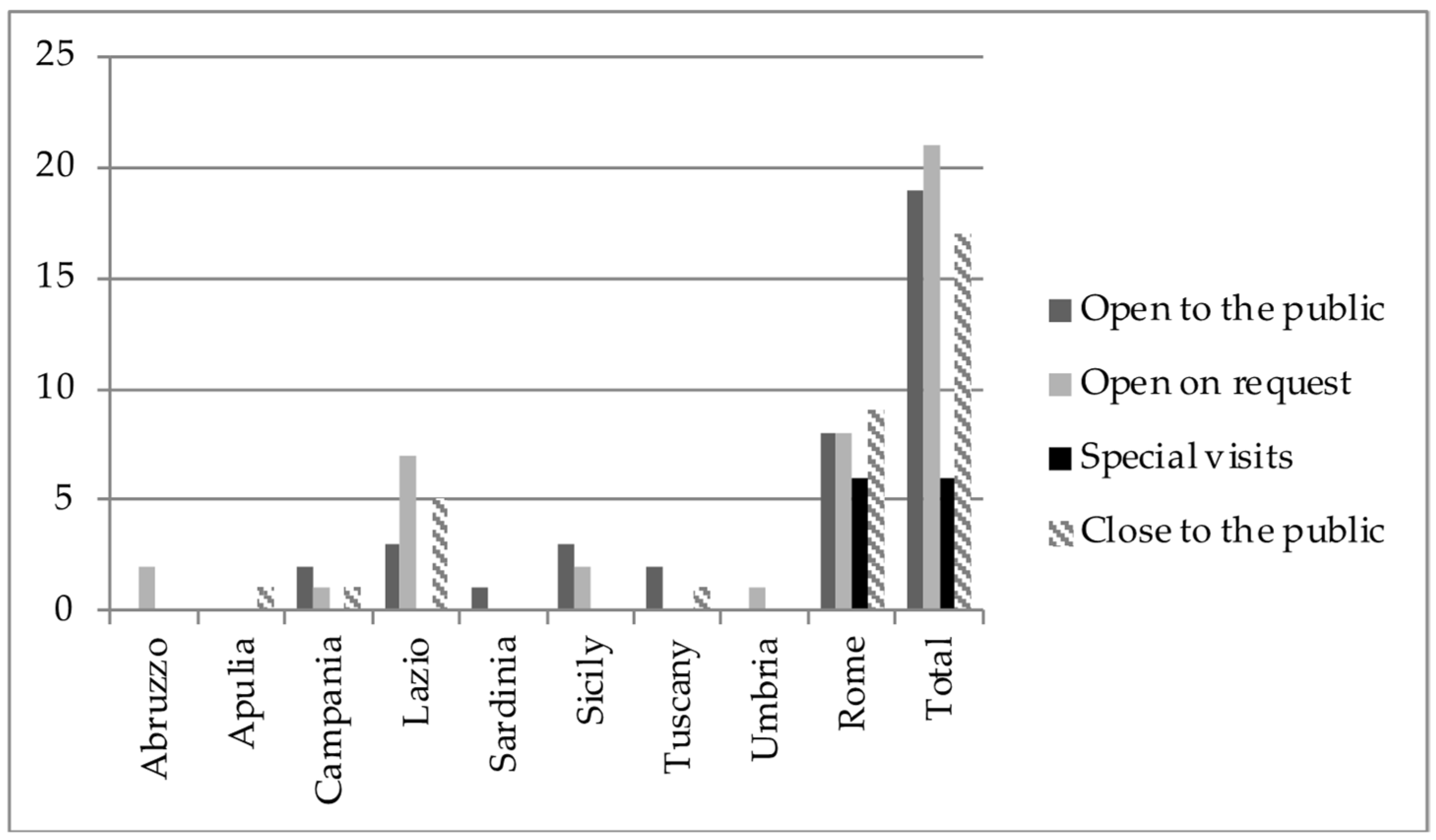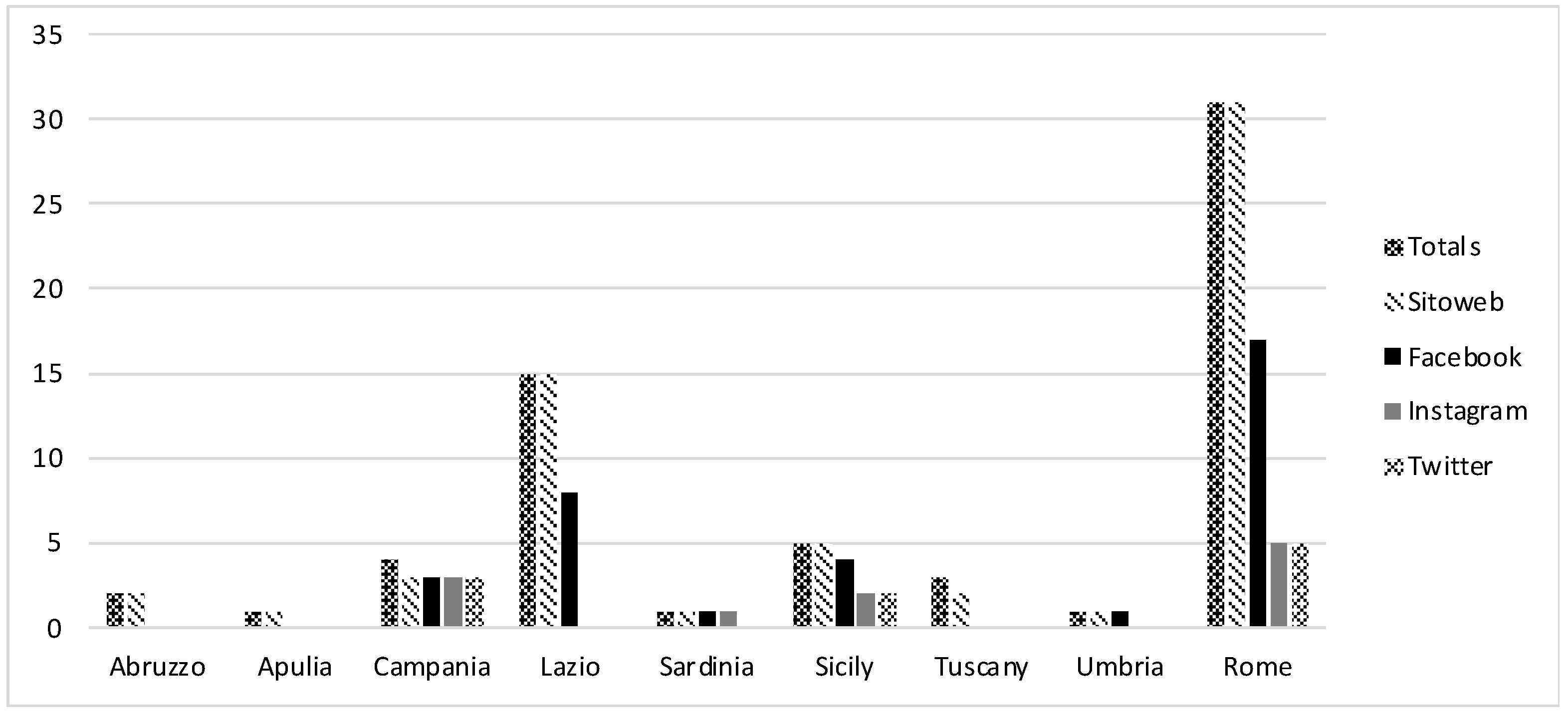Italian Catacombs and Their Digital Presence for Underground Heritage Sustainability
Abstract
:1. Introduction
2. Catacombs of Italy
3. Materials and Methods
4. Results
4.1. Type of Visit
4.2. Multimedia Tools and Social Pages
4.3. Reviews
5. Discussion
Author Contributions
Funding
Institutional Review Board Statement
Informed Consent Statement
Data Availability Statement
Conflicts of Interest
References
- Pesme, C. Contemporary Theory of Conservation. Stud. Conserv. 2010, 55, 315–316. [Google Scholar] [CrossRef]
- Clark, K. Capturing the Public Value of Heritage. In Proceedings of the London Conference, Swindon, UK, 25–26 January 2006. [Google Scholar]
- United Nations Educational Scientific and Cultural Organization. Rio20 United Nations Conference on Sustainable Development 1–53. In Proceedings of the Future We Want: Final Document of the Rio+20 Conference, Rio de Janeiro, Brazil, 20–22 June 2012. [Google Scholar]
- United Cities and Local Governments (UCLG). Culture: Fourth Pillar of Sustainable Development. 2010. Available online: www.uclg.org (accessed on 10 June 2021).
- Jin, Y. GIS-based and Statistical Approaches to Explore Relationship between Heritage and Urban Sustainable Development: A Cases Study on Liverpool, England; University College London: London, UK, 2018. [Google Scholar]
- Murti, R. Natural Heritage—A Nature based Solution for Resilience to Disasters. In Proceedings of the 3rd International Symposium on Nature-Culture Linkages in Heritage Conservation in Asia and the Pacific: Disaster and Resilience, Tsukuba, Japan, 21 September–1 October 2018. [Google Scholar]
- Pereira Roders, A.; van Oers, R. Bridging cultural heritage and sustainable development. J. Cult. Herit. Manag. Sustain. Dev. 2011, 1, 5–14. [Google Scholar] [CrossRef]
- Kou, H.; Zhou, J.; Chen, J.; Zhang, S. Conservation for Sustainable Development: The Sustainability Evaluation of the Xijie Historic District, Dujiangyan City, China. Sustainability 2018, 10, 4645. [Google Scholar] [CrossRef] [Green Version]
- Keitumetse, S.O. Cultural resources as sustainability enablers: Towards a community-based cultural heritage resources man-agement (COBACHREM) model. J. Sustain. Tour. 2014, 6, 70–85. [Google Scholar] [CrossRef] [Green Version]
- Rosetti, I.; Pereira Roders, A.; Jacobs, M. Heritage and sustainability: A reflection on the role of partecipatory heritage practices in sustainable development. In Proceedings of the LDE Heritage Conference on Heritage and the Sustainable Development Goals Proceedings, Delft, Holand, 26–28 November 2019. [Google Scholar]
- Pace, G.; Ismed-Cnr, I. Underground Built Heritage as catalyser for Community Valorisation. In Underground Built Heritage Valorisation. A handbook, Proceedings of the First Training School; Salvarani, R., Pace, G., Eds.; CNR Edizioni: Rome, Italy, 2019. [Google Scholar] [CrossRef]
- Sharpley, R. Tourism and Sustainable Development: Exploring the Theoretical Divide. J. Sustain. Tour. 2000, 8, 1–19. [Google Scholar] [CrossRef]
- Cole, D. Exploring the Sustainability of Mining Heritage Tourism. J. Sustain. Tour. 2004, 12, 480–494. [Google Scholar] [CrossRef]
- Rodwell, D. Sustainability and the Holistic Approach to the Conservation of Historic Cities. J. Arch. Conserv. 2003, 9, 58–73. [Google Scholar] [CrossRef]
- Wilson, L.-A.; Boyle, E. Interorganisational collaboration at UK World Heritage Sites. Leadersh. Organ. Dev. J. 2006, 27, 501–523. [Google Scholar] [CrossRef]
- Landorf, C. Managing for sustainable tourism: A review of six cultural World Heritage Sites. J. Sustain. Tour. 2009, 17, 53–70. [Google Scholar] [CrossRef]
- Ryberg, S.R. Neighborhood Stabilization through Historic Preservation: An Analysis of Historic Preservation and Community Development in Cleveland, Providence, Houston and Seattle; University of Pennsylvania: Philadelphia, PA, USA, 2010. [Google Scholar]
- Snyder, M.R. The Role of Heritage Conservation Districts in Achieving Community Improvement; University of Waterloo: Waterloo, ON, Canada, 2008. [Google Scholar]
- Boeri, A.; Gaspari, J.; Gianfrate, V.; Longo, D.; Pussetti, C. The adaptive reuse of historic city centres. Bologna and Lisbon: Solutions for urban regeneration. J. Technol. Archit. Environ. 2016, 230–237. [Google Scholar]
- ICOMOS. Cultural Heritage, the UN Sustainable Development Goals, and the New Urban Agenda. 2016, p. 23. Available online: http://www.usicomos.org/wp-content/uploads/2016/05/Final-Concept-Note.pdf (accessed on 15 July 2021).
- Cameron, F.; Kenderdine, S. Beyond the Cult of the Replicant: Museums and Historical Digital Objects: Traditional Concerns, New Discourses. 2007. Available online: https://researchdirect.westernsydneyedu.au/islandora/object/uws:11475/ (accessed on 12 October 2021).
- Krubu, D.E.; Osawaru, K.E. The Impact of Information and Communication Technology (ICT) in Nigerian University Librarides, 2011, Library Philosophy and Practice. Available online: https://digitalcommons.unl.edu/cgi/viewcontent.cgi?article=1614&context (accessed on 18 October 2021).
- Pujol, L.; Champion, E. Evaluating presence in cultural heritage projects. Int. J. Heritage Stud. 2012, 18, 83–102. [Google Scholar] [CrossRef]
- Loach, K.; Rowley, J.; Griffiths, J. Cultural sustainability as a strategy for the survival of museums and libraries. Int. J. Cul. Pol. 2019, 23, 58–70. [Google Scholar] [CrossRef]
- Catacombe d’Italia. Available online: http://www.catacombeditalia.va/content/archeologiasacra/it.html (accessed on 30 June 2021).
- Peterson, J. Virtual Reality, Augmented Reality, and Mixed Reality Definitions (Version 1.0 07/07/2017) CEO ContentBridge Systems & Ramón Bretón, CTO 3rd i QC; USC Entertainment Technology Center, 2017 with Input from Philip Lelyveld. Available online: https://godigitalmg.com/wp-content/themes/godigital/media/whitepaper/2017-EMA-VR-AR-MR-Definitions-Final-1.pdf (accessed on 6 October 2021).
- Seychell, D.; Dingli, A. Rediscovering Heritage through Technology. Stud. Comput. Intel. 2020, 859. [Google Scholar]
- Cameron, F.; Kenderdine, S. Theorizing Digital Cultural Heritage: A Critical Discourse; Media in Transition; The MIT Press: Cambridge, UK, 2007. [Google Scholar]
- Peruzzi, L.; Google Arts & Culture. Una banca dati gratuita tra informazione ed emozione. Bibl. Og. 2019, 37, 4–20. [Google Scholar]
- European Commission. Available online: https://ec.europa.eu/culture/policies/selected-themes/cultural-heritage (accessed on 30 August 2021).



| Region/City | Name of Catacombs |
|---|---|
| Abruzzo | Catacomba di S. Vittorino ad Amiterno (AQ) |
| Catacomba di Castelvecchio Subequo (AQ) | |
| Apulia | Complesso monumentale di Lamapopoli (Canosa, BT) |
| Campania | Catacomba di S. Gaudioso (NA) |
| Catacomba di S. Gennaro (NA) | |
| Catacomba di S. Efebo (NA) | |
| Catacomba di S. Severo (NA) | |
| Lazio | Catacomba di S. Cristina a Bolsena (VT) |
| Catacomba di Colle S. Quirico a Paliano (FR) | |
| Catacomba di S. Eutizio, Soriano nel Cimmino (VT) | |
| Catacomba di S. Savinilla a Nepi (VT) | |
| Catacomba del Ss. Gratiliano e Felicissima, Falerii Novi (VT) | |
| Catacomba di Visentium, Capodimonte VT | |
| Catacomba di Gratte, Bolsena (VT) | |
| Catacomba di S. Vittoria a Monteleone Sabino (RI) | |
| Catacomba Ad Decimum, Grottaferrata (RM) | |
| Catacomba di Monte Stallone a Formello (RM) | |
| Catacomba ad Vicesimum, Morlupo (RM) | |
| Catacomba di S. Senatore ad Albano (RM) | |
| Catacomba di “Monte della Casetta”, Capena (RM) | |
| Catacomba di S. Teodora a Rignano Flaminio (RM) | |
| Catacomba di S. Ilario “ad Bivium” presso Valmontone (RM) | |
| Sardinia | Catacomba di S. Antioco (CI) |
| Sicily | Catacomba di Porta d’Ossuna (PA) |
| Catacomba di S. Giovanni a Siracusa (SR) | |
| Catacomba di Santa Lucia (SR) | |
| Catacomba di Vigna Cassia (SR) | |
| Catacomba di Villagrazia di Carini (PA) | |
| Tuscany | Catacomba dell’Isola di Pianosa Portoferraio (LI) |
| Catacomba di S. Caterina Chiusi (SI) | |
| Catacomba di S. Mustiola Chiusi (SI) | |
| Umbria | Catacomba di Villa S. Faustino a Massa Martana (PG) |
| Rome | Catacomba di Domitilla (RM) |
| Catacomba di S. Pancrazio (RM) | |
| Catacomba di S. Agnese (RM) | |
| Catacomba di S. Callisto (RM) | |
| Catacomba di Priscilla (RM) | |
| Catacomba di S. Sebastiano (RM) | |
| Catacomba di Generosa (RM) | |
| Cimitero Maggiore (RM) | |
| Catacomba di S. Ermete o Bassilla (RM) | |
| Catacomba di S. Felicita o di Massimo (RM) | |
| Catacomba di S. Lorenzo (o Ciriaca) (RM) | |
| Catacomba di Vigna Chiaraviglio (RM) | |
| Catacomba di Commodilla (RM) | |
| Catacomba di S. Tecla (RM) | |
| Museo della Torretta e Cripte di Lucina (RM) | |
| Museo e Catacomba di Pretestato (RM) | |
| Ipogeo degli Aureli in Viale Manzoni (RM) | |
| Museo di Domitilla e Regione dei Fornai (RM) | |
| Catacomba Anonima di Via Anapo (RM) | |
| Catacomba dei Giordani (RM) | |
| Catacomba di S. Valentino (RM) | |
| Catacomba di Vibia (RM) | |
| Catacomba di S. Ippolito (RM) | |
| Catacomba di Panfilo (RM) | |
| Catacomba dei SS. Marco, Marcelliano e Damaso (RM) | |
| Catacomba di Calepodio (RM) | |
| Ipogeo di Via Dino Compagni (RM) | |
| Catacomba della Nunziatella (RM) | |
| Catacomba di Roma Vecchia, Parco degli Acquedotti (RM) | |
| Catacomba di S. Zotico, Vermicino (RM) | |
| Catacomba di S. Alessandro sulla Via Nomentana (RM) |
| Open to the Public 18 | Open on Request 20 | Special Visits 6 | Closed to the Public 19 | |
|---|---|---|---|---|
| SOCIAL MEDIA | ||||
| Website | 17 | 19 | 6 | 19 |
| 14 | 13 | 1 | 6 | |
| 8 | 1 | 0 | 3 | |
| 5 | 2 | 1 | 3 |
| Open to the Public 18 | Open on Request 20 | Special Visits 6 | Close to the Public 19 | |
|---|---|---|---|---|
| MULTIMEDIA TOUR | ||||
| Google Maps | 0 | 0 | 0 | 1 |
| Google Art and Culture | 2 | 0 | 0 | 0 |
| YouTube | 14 | 12 | 5 | 11 |
| VIRTUAL TOUR | ||||
| IMMERSIVE REALITY | 0 | 0 | 0 | 0 |
| Open to the Public 18 | Open on Request 20 | Closed to the Public 19 | Special Visits 6 | |
|---|---|---|---|---|
| REVIEWS | ||||
| TripAdvisor | 18 | 11 | 11 | 4 |
| Google Reviews | 17 | 11 | 8 | 3 |
Publisher’s Note: MDPI stays neutral with regard to jurisdictional claims in published maps and institutional affiliations. |
© 2021 by the authors. Licensee MDPI, Basel, Switzerland. This article is an open access article distributed under the terms and conditions of the Creative Commons Attribution (CC BY) license (https://creativecommons.org/licenses/by/4.0/).
Share and Cite
Presti, O.L.; Carli, M.R. Italian Catacombs and Their Digital Presence for Underground Heritage Sustainability. Sustainability 2021, 13, 12010. https://doi.org/10.3390/su132112010
Presti OL, Carli MR. Italian Catacombs and Their Digital Presence for Underground Heritage Sustainability. Sustainability. 2021; 13(21):12010. https://doi.org/10.3390/su132112010
Chicago/Turabian StylePresti, Olga Lo, and Maria Rosaria Carli. 2021. "Italian Catacombs and Their Digital Presence for Underground Heritage Sustainability" Sustainability 13, no. 21: 12010. https://doi.org/10.3390/su132112010
APA StylePresti, O. L., & Carli, M. R. (2021). Italian Catacombs and Their Digital Presence for Underground Heritage Sustainability. Sustainability, 13(21), 12010. https://doi.org/10.3390/su132112010






